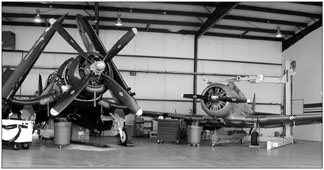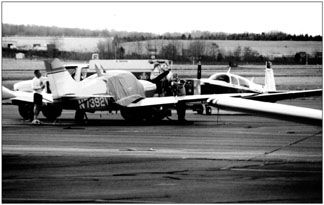I recently listened to an aviation insurance official cite a collection of claims for aircraft damaged during ground operations and dropped my jaw. The cost of even the smallest hangar rash can be quite expensive to your-or your insurance companys-checkbook.
Light materials like sheet and stamped aluminum or composites can carry amazing structural loads as long as the integrity of their shape is maintained. But, a small dent can seriously compromise the load-carrying capability of the structure. Repairs of more substantial damage-to a nosegear, a wingtip or a tail surface-can easily exceed the value of an older pride-and-joy, forcing you or the insurance company to total it. And the repair cost alone does not consider the expense of downtime. In the case of aircraft, its much cheaper and a lot less painful to prevent hangar rash in the first place than to pay for the damage afterwards.
Towing
The risk of damage during ground operations definitely goes highest when an aircraft is towed. There are many precautions that should be followed to reduce this risk.
For example, before moving the aircraft, you should thoroughly inspect all sides of its perimeter and the proposed path of movement, looking for obstructions anywhere close to the aircrafts wings and tail. You should also examine the pavements condition and drains to make certain the aircraft isnt towed over a suspect surface. When using a tug, its inspections should be current and proper braking action assured. It would be quite a disaster if the brakes on the tug were to give out during the towing operating.
In addition to ensuring the equipment is up to the task, its wise to have at least two wing walkers while moving the aircraft with a tug. The tug operator should maintain continuous visual contact with the wing walkers in case one spots a possible collision. If the tug operator loses sight of a wing walker, he or she should immediately stop.
Needless to say, if there is any doubt that sufficient clearance exists, a wing walker should command an immediate stop. It should go without saying that the aircraft should be towed at a slow walking speed. If the aircraft is going to be pushed into a spot or a hangar, a spotter should be positioned at the back of the aircraft with visual eye contact to the tug driver to prevent the aircraft from being pushed into an obstacle.
Ramp Movements
The damage risk is second highest when an aircraft is moved under its own power on a ramp. The list of ramp hazards that has caused aircraft damage is long.
For example, there are instances of aircraft taxiing over a drain grate, only to have it collapse. Often, narrow rows of aircraft are parked nearby, allowing too little room for a taxiing aircraft. Similarly, the parking spaces for aircraft are often too closely spaced. Sometimes, the ramps have a distinct slope, which is made worse during icy or snow-covered conditions.Prop and jet blast from other aircraft is always a hazard, especially when it blows loose items into nearby aircraft. Vehicles will always be hazard on a ramp.
Whenever taxiing onto a ramp, you should slow down and visually scan for any of these hazards. Use the FBOs Unicom to report your position and obtain directions or taxi-in assistance.
Some ramps have blind spots or sharp turns around corners of buildings that dont allow the pilot to see whats next-or whats coming. These are situations prone to ground collisions.
Sometimes ground marshallers are available. They can be helpful to avoid ground collisions, though nearly half of the aircraft damaged in the FAAs incident database were under the direction of ground marshallers at the time.If ground marshallers dont provide the correct hand signals at the start, you should probably be concerned that they havent been trained properly.Ground marshallers are not able to have complete 360-degree vision around your aircraft. If the ramp appears to be confined, ask the ground marshaller to have wing walkers. Only a wing walker standing in close proximity to your wing tips and tail can clearly observe the distance between your aircraft and a nearby obstacle.
Its still necessary for you to maintain awareness of your proximity to nearby obstacles. So how can you determine if your aircrafts wing tips are too close to a nearby obstacle? One technique that works well when the sun is high is comparing the shadows on the ground. When in doubt, enlist the help of a qualified person to check the distance. If no one is available, then shut down the engine (or have someone qualified hold the brakes), get out of the aircraft and see for yourself. If a ramps parking spot is really that tight, it wont hurt you to park further out and walk an additional few yards. And it will be cheaper than trying to squeeze into a tight parking spot and damaging your aircraft along with someone elses.
Often I see aircraft cutting across a ramp at a skewed angle, I guess to save a few precious seconds on the Hobbs meter. The best advice is to follow the yellow-brick road: Stay on the taxiway and ramp centerlines. This is especially true if your airplane has relatively little prop clearance. Ramps often have chocks laying around, and sometimes other equipment is left out also, particularly near parking spots.
Those centerlines were painted to keep an average aircrafts wingtips from striking parked aircraft. Besides being an additional guide, the chances of a stray chock laying in the middle of a taxi route are somewhat less. Prop strikes on pavement arent unheard of and even a minor prop strike is grounds for an extensive-and expensive-engine tear-down and inspection. Its imperative to taxi slowly and on an uncontaminated, smooth ramp if you fly something with little prop clearance.
While taxiing your aircraft, particularly in the ramp area, your attention should be solely outside of the aircraft. Checklists and other concurrent duties need to wait until you are out of the ramp area and either in the run-up area or on a long, straight, uncongested taxiway. A crowded ramp is no place to perform anything but extra vigilance outside of the aircraft.

Vehicles On The Ramp
The risk is third highest when ground-service equipment is moved around aircraft. Whether its a fuel truck rolling between aircraft, a tug towing an external power unit or a personal SUV hauling baggage out to an aircraft, vehicles moving around on ramps have damaged a lot of wingtips.
One large fuel provider now requires its personnel to place chocks on the back tires of its fueling trucks. When I heard of this policy, I assumed that main purpose was to prevent the vehicle from rolling into an aircraft, but that was only part of the reason for this procedure. The other intent was to force the vehicle operator to get out of the truck and walk around to the back and remove the chocks before attempting to drive away, thus forcing the lineman to visually inspect the rear area surrounding the service vehicle.Clever! Has it worked? So far, their rate of ramp damage incidents by service vehicles has shown a remarkable decline.
With the recent spotlight on the security of general aviation aircraft in the aftermath of 9/11, access to most ramps has been tightened. Hopefully this will cut down on the number of ground vehicles driving on aircraft ramps, which will hopefully drive down the number of ground incidents. A ramp with restricted vehicle access will tend to be a safer ramp.
Sometimes ramps have a slight slope, or sometimes brakes fail on a vehicle. When a vehicle stops on a ramp, it should be positioned so that it would roll away from aircraft. If a vehicle is parked on the ramp so that it could roll into an aircraft, this needs to be brought to the attention of the driver and the vehicle repositioned. When vehicles are left unattended on a ramp, the engines should be turned off, parking brakes set, and preferably a set of chocks placed under the tires to keep the vehicle from rolling.
Hangaring
The fourth riskiest event for ground damage occurs during hangar movements. Hangar doors need to be fully opened any time you are moving an aircraft into or out of a hangar. It hurts to look at pictures of nice aircraft whose wings and propellers struck hangar doors that werent fully open-if only the pilot had fully opened the doors! Hangar doors should also be secured to prevent inadvertent closure due to prop blast or winds.
Think, also, about what can happen inside the hangar once the aircraft is parked and the doors closed. For example, overlapping wings can be another source of aircraft damage if tires become deflated. I would have never considered this, but the industry official showed a series of pictures of an incident in this exact scenario happened. It would have been a non-event except that the wings overlapped other aircraft.
Floor markings guiding ground handlers when moving the aircraft and alert the crew to the best entry and exit positions are recommended. The limits should be clearly marked. This is particularly applicable when the aircraft is being pushed into a hangar since it is difficult for the tow operator to maintain an accurate perception of the rear area of the aircraft.
Human Factors
It shouldnt come as a surprise that being rushed was the leading factor in many ground-handling incidents. Its very clear that attempt to hurry while getting an aircraft moved dramatically increases the risk of ground damage.
When I flew air ambulance missions, we kept our aircraft in a hangar to protect it from the elements. When the red phone rang, there was a perception of time pressure to get the aircraft out of the hangar in a hurry and have the aircrafts engines ready to crank as soon as the hospital crew arrived. To guard against this mission-induced time pressure, I would have the aircraft fully preflighted at the beginning of the tour and have the tug already hooked up when the phone rang. The strategy worked because I was always waiting for the nurses to arrive.
Time pressure is the second leading overall factor that increases the chances of human error. When bad weather approaches, waiting until the last minute to get an aircraft into a hangar also increases risk. Its much wiser to perform such important tasks when you have the time and can take the proper precautions.
Conclusion
Factors associated with hangar rash are common to many ramps: Aircraft are often spaced too closely together, the ramp may be slick, and nighttime illumination may be poor. Obstructions are often present, and it can be difficult to hear a warning on the average noisy ramp.
Aviation safety is usually thought to involve the in-flight phases, but ramps and hangars can be just as hazardous. They demand the same level of care and attention.
Also With This Article
“Ground-Handling Dos And Donts”
“You Make The Call”
-Pat Veillette is an aviation safety researcher who flies transports for a living.





This article was good common sense safety rules .